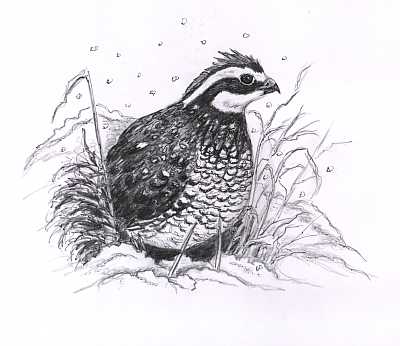
Dear Bird Folks:
This nasty, relentless winter has me worried about our Bobwhite Quail. I can’t believe that those little balls of fluff are going to be able to survive all this snow and cold. Are they going to be okay?
– Debra, Truro
First of All Deb,
I’ll only answer your question if you promise never to use the term “little balls of fluff” again. I may not be the most scientific guy, but I draw the line at little balls of fluff. People will start to think that I’ve turned into Doris Day or a golfer. So no more fluff talk. Promise?
Bobwhites are our only native quail found east of the Mississippi River. Your concern for them is well founded. Even though these little quail are called “Northern” Bobwhites, they are not really northern birds. Cape Cod is pretty much the northern limits of their range. Yet, up until this winter, living on Cape Cod was a good choice. For years we, and the quail, would sit back and laugh at all those losers inland who were getting tons of snow and ice while we got rain and fog. Well, as you know, that all has changed this winter. This winter has been hard on all wildlife and bobwhites may be hit the hardest. They can’t pack up and head to Boca Raton, no matter how tough this winter gets.
Unlike most birds, quail are sedentary. They don’t have the ability to take long migrations. They must work things out where they are born. When our ponds freeze up, the ducks simply fly off until they find some open water. When food sources are covered by snow, many songbirds fly off in search of available food. Bobwhites, on the other hand, like the people in Boston’s North End or Southie, live their entire lives within a half mile of where they were hatched.
I’m not trying to say that bobwhites are whimpy birds, they are not. They are able to tough out this ridiculously cold weather. The cold is not the problem, it is finding enough food. If the birds can remain fat and happy, they can deal with our recent low temperatures. Finding food is the key.
Again, unlike most birds, quail live, eat and sleep on the ground. Even though they can fly, they are programmed to look for food on the ground and rarely look any place else. The combination of the stressful frigid air and snow covering food supplies equals bad news for bobwhites.
A third and even more deadly element is freezing rain. As most of you know, quail sleep in a tight circle. The tight circle allows protection from the wind while sharing body heat. Falling snow covers the sleeping birds in a protective blanket of white that insulates them from the colder air. A serious problem can arise if the snow turns to freezing rain that forms a crust over the snow. Bobwhites can be trapped under the layer of ice and will starve if they cannot break free. If they do break out, there is still the matter of digging back throughout the icy crust to find food.
By itself, this nasty winter should not have long-term impact on our bobwhite population. However, when bad weather is combined with habitat loss and uncontrolled pets, the outlook is not so good. Some years 80% of the quail population does not live to see the spring. The Cape population of bobwhites should recover from this hard winter, if they are able to find an unspoiled, predator-free area to nest in.
An interesting note about quail is that anytime their population has a significant drop, the remaining birds answer the call by stepping up their breeding and producing more young. That’s a call that the quail, especially the males, don’t mind answering.